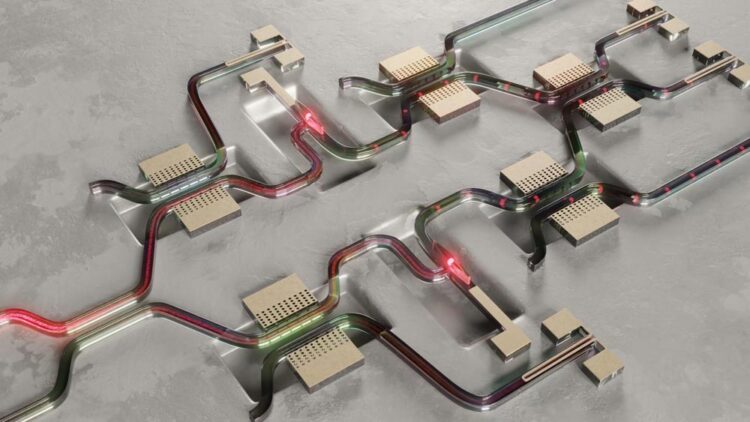Heat-free optical switch would enable optical quantum computing chips

Illustration of a controlled quantum circuit enabled by the reported heat-free switches.
Credit: Lucas Schweickert
In a potential boost for quantum computing and communication, a European research collaboration reported a new method of controlling and manipulating single photons without generating heat. The solution makes it possible to integrate optical switches and single-photon detectors in a single chip.
Publishing in Nature Communications, the team reported to have developed an optical switch that is reconfigured with microscopic mechanical movement rather than heat, making the switch compatible with heat-sensitive single-photon detectors.
Optical switches in use today work by locally heating light guides inside a semiconductor chip. “This approach does not work for quantum optics,” says co-author Samuel Gyger, a PhD student at KTH Royal Institute of Technology in Stockholm.
“Because we want to detect every single photon, we use quantum detectors that work by measuring the heat a single photon generates when absorbed by a superconducting material,” Gyger says. “If we use traditional switches, our detectors will be flooded by heat, and thus not work at all.”
The new method enables control of single photons without the disadvantage of heating up a semiconductor chip and thereby rendering single-photon detectors useless, says Carlos Errando Herranz, who conceived the research idea and led the work at KTH as part of the European Quantum Flagship project, S2QUIP.
Using microelectromechanical (MEMS) actuation, the solution enables optical switching and photon detection on a single semiconductor chip while maintaining the cold temperatures required by single-photon detectors.
“Our technology will help to connect all building blocks required for integrated optical circuits for quantum technologies,” Errando Herranz says.
“Quantum technologies will enable secure message encryption and methods of computation that solve problems today’s computers cannot,” he says. “And they will provide simulation tools that enable us to understand fundamental laws of nature, which can lead to new materials and medicines.”
The group will further develop the technology to make it compatible with typical electronics, which will involve reducing the voltages used in the experimental setup.
Errando Herranz says that the group aims to integrate the fabrication process in semiconductor foundries that already fabricate on-chip optics – a necessary step in order to make quantum optic circuits large enough to fulfill some of the promises of quantum technologies.
###
Financial support for the research was made possible by the European Union’s Horizon 2020 research and innovation program under grant agreement No. 820423 (S2QUIP); the Swedish Research Council, the Knut and Alice Wallenberg Foundation, the State of Upper Austria, and the Austrian Science Fund.
The work was co-supervised at KTH by Professor Val Zwiller at KTH and Professor Klaus D. Jöns (now at Paderborn University, Germany). Errando Herranz is now a researcher at Massachusetts Institute of Technology (MIT), in the U.S. Contributing to the study were researchers from Linz Institute of Technology and Johannes Kepler University, in Austria.
All latest news from the category: Information Technology
Here you can find a summary of innovations in the fields of information and data processing and up-to-date developments on IT equipment and hardware.
This area covers topics such as IT services, IT architectures, IT management and telecommunications.
Newest articles

An Endless Loop: How Some Bacteria Evolve Along With the Seasons
The longest natural metagenome time series ever collected, with microbes, reveals a startling evolutionary pattern on repeat. A Microbial “Groundhog Year” in Lake Mendota Like Bill Murray in the movie…

Witness Groundbreaking Research on Achilles Tendon Recovery
Achilles tendon injuries are common but challenging to monitor during recovery due to the limitations of current imaging techniques. Researchers, led by Associate Professor Zeng Nan from the International Graduate…

Why Prevention Is Better Than Cure—A Novel Approach to Infectious Disease Outbreaks
Researchers have come up with a new way to identify more infectious variants of viruses or bacteria that start spreading in humans – including those causing flu, COVID, whooping cough…



